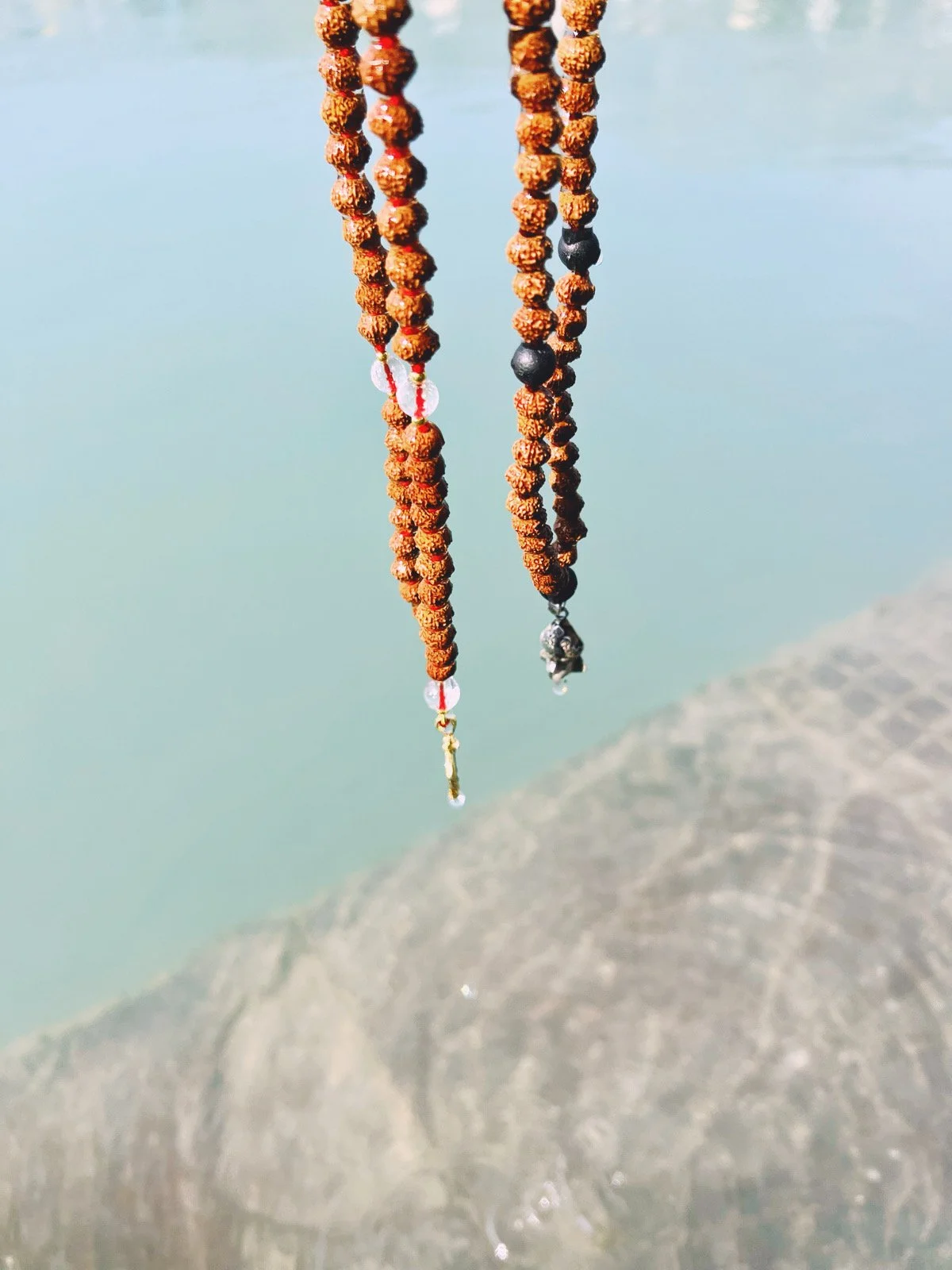What is japa? How do you practice japa? How do you use a mala?
The “Word” is one of the most powerful devices for transforming your perceptions of daily life experiences. — Ram Dass
Japa is a mantra recitation practice where you commit to a target number of one particular mantra while incorporating the support of a string of mala beads.
Japa means, “rotate,” and the use of mala beads helps to tether the mind to a kinesthetic sensation, reminding you to focus the mind as you repeat a word or phrase associated with your deepening spiritual awareness.
Doing japa with a mantra, a heart-mind vehicle, repatterns the thinking mind, and brings you into moment-to-moment awareness.
As one slowly moves along the mala, the mind becomes rooted in that same, unhurried, calm movement, directing awareness into clear focus.
While not necessary to specifically use Sanskrit mantras, when you do work with an ancient mantra you’re also working with the embedded charge of an age-old sound current.
What is a mala?
A full mala consists of 108 beads. Why 108? We’ll save that deep dive for another day, but for now, just know that it’s based on the sacred number 3—the trinity of trinity is 9, and 1+0+8=9. (Also, 9 is the number of planets in Vedic Astrology.) A mala is a constant reminder of, and connection with, these sacred numbers.
A mala itself is not a magical artifact, rather it’s a sacred tool for yoga practice the same way as asana, food, music or other sound vibrations. A mala’s significance is derived from the intention and sincerity of the user, and they are best worn under clothing so they’re touching your skin when you’re not using them.
Malas are made from wood, seeds, semi-precious gemstones, or precious gemstones and strung with a durable thread or cord. Semi-precious gemstones and precious gemstones aligned with the nine planets of Vedic astrology (Sun, Moon, Jupiter, Venus, Mars, Mercury, Saturn, Rahu, and Ketu) all embody intense concentrations of energy. They activate transformation and realization by supporting the specific and unique needs of an individual.
The gemstone itself does not offer what a person needs, but rather it offers a tool for shifting in that direction.
Additionally, two varieties of seeds and of wood are commonly used for malas. The Bodhi seed is symbolic of the Buddha (he attained enlightenment under the Bodhi tree). The Rudraksha seed represents the eye of Shiva. Both Rosewood and Sandalwood beads are also common.
What are the benefits of japa?
You would take japa on as a sadhana (spiritual practice)—it can be a meditation, or it can be woven into your day wherever you see fit. The real magic happens when you overcome the innate resistance that arises through the practice.
The benefits of a japa practice are numerous and as unique as the practitioner. Some include:
Reduced anxiety
More gratitude
Deeper ease
Increased focus
Less attachment to thoughts + stories
Rewriting the script of our monkey mind
Greater autonomy of our thoughts
Deeper reverence for the mysticism of life
Weaving spirituality into small moments of life
Living life as an offering
Expanding our consciousness
A way to fall asleep
Something to do when waiting in line
Cultivates will power and self-respect
Makes meditation accessible
Invites in subtle energy to do the heavy lifting
Quiets life’s agitation
…and SO much more!
“MANTRA IS LIKE A KEY THAT OPENS THE DOOR TO A PLACE IN THE UNIVERSE. AND SINCE EVERY SOUND THAT'S EVER BEEN MADE WILL ALWAYS EXIST, THE VOICES OF EVERYBODY WHO EVER DID THAT MANTRA ARE STILL PRESENT IN THAT PLACE."— Ram Dass
How to rotate the mala beads?
Now, there are many different beliefs on how to rotate the beads—this is not something to get hung up on and aim for perfection in. Rotating the beads the way that feels most accessible to you is paramount.
With that said, the way I have been taught is to avoid using your pointer finger to thread the beads. This finger is related to the planet Jupiter which is also related to the ego and the trappings of expanding the ego. Rather than expanding, japa aims to harness and focus the mind.
Thus, we call on the disciplinary, Saturn, and / or the illuminating value of Surya, the Sun.
Using the thumb and your middle finger (the Saturn finger) or your ring finger (Sun’s designated finger) brings in a subtler quality of anchoring to the japa practice. It’s also been said that there’s a nerve in your ring finger that is connected to your spine that adds a little extra acupressure benefit to the practice.
However, I have also seen other cultures like the Tibetans in Dharamshala, for example, that have no such rules and use their malas in either hand with any finger.
You don’t even need to use the beads, necessarily! You can count to twelve on one hand and nine on the other to keep track (12x9 = 108). To count to twelve, simply connect your thumb to each portion of the finger’s pad (three per finger, as divided up by the knuckle lines) and systematically move to the next finger (3x4 = 12). Start again when you get to twelve and just nudge your opposite hand down from the first finger pad to the second finger pad (of the index finger, for example).
What mantras can you use for a japa practice?
Select a mantra that is special to you. You may choose to recite the mantra aloud or silently, or begin aloud and transition to silence.
Each recitation and movement of mala beads should be in rhythm and harmony. You may chant 108, 54, or 27 times (full, half, or quarter mala).
For tapas (discipline), set an intention to complete 11,000 or 21,000 rounds of the mantra within a specific time period (like 21, 40, or 54 days).
Sample Japa Mantras + Free Recordings on InsightTimer:
Lakshmi:
OM SHRIM MAHA LAKSHMIYE NAMAHA Durga:
OM DUM DURGAYE NAMAHA Ganesha:
OM GAN GANAPATAYE NAMAHA Shiva:
OM NAMAH SHIVAYA *Credit to Sattva Yoga Academy for much of this wisdom.



